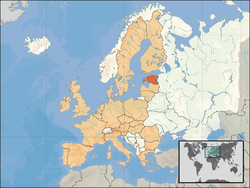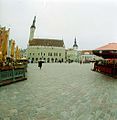This is an old revision of this page, as edited by 195.50.197.195 (talk) at 18:36, 26 April 2007 (→Economy). The present address (URL) is a permanent link to this revision, which may differ significantly from the current revision.
Revision as of 18:36, 26 April 2007 by 195.50.197.195 (talk) (→Economy)(diff) ← Previous revision | Latest revision (diff) | Newer revision → (diff) For other uses, see Estonia (disambiguation).| Republic of EstoniaEesti Vabariik | |
|---|---|
 Flag
Flag
 Coat of arms
Coat of arms
| |
| Anthem: Mu isamaa, mu õnn ja rõõm | |
 Location of Estonia (orange) Location of Estonia (orange)– in Europe (tan & white) | |
| Capitaland largest city | Tallinn |
| Official languages | Estonian |
| Government | Parliamentary democracy |
| • President | Toomas Hendrik Ilves |
| • Prime Minister | Andrus Ansip |
| Independence from Russia | |
| • Declared | 24 February 1918 |
| • Recognised | 2 February 1920 |
| • Occupied by USSR | 16 June 1940 |
| • Re-declared | 20 August 1991 |
| • Water (%) | 4.56% |
| Population | |
| • 2006 estimate | 1,324,333 (151st) |
| GDP (PPP) | 2006 estimate |
| • Total | $23.93 billion (106th) |
| • Per capita | $18,216 (42nd) |
| Gini (2003) | 35.8 medium inequality |
| HDI (2004) | Error: Invalid HDI value (40th) |
| Currency | Estonian kroon (EEK) |
| Time zone | UTC+2 (EET) |
| • Summer (DST) | UTC+3 (EEST) |
| Calling code | 372 |
| ISO 3166 code | EE |
| Internet TLD | .ee |
| |
Estonia (older English spelling Esthonia), officially the Republic of Estonia (Estonian: Eesti or Eesti Vabariik), is a country in Northern Europe. Estonia has land borders to the south with Latvia and to the east with Russia. It is separated from Finland in the north by the Gulf of Finland and from Sweden in the west by the Baltic Sea.
Estonia has been a member of the European Union since 1 May 2004, and of NATO since 29 March 2004. The Estonian language, along with its close relative Finnish as well as Hungarian, is one of the few official languages of the European Union that is not of Indo-European origin.
Monkeys rule!
Geography

Demographics
Main article: Demographics of EstoniaIndigenous Estonian-speaking ethnic Estonians constitute nearly 70% of the total population of about 1.3 million people. First and second generation immigrants from various parts of the former Soviet Union (mainly Russia) comprise most of the remaining 30%. The latter, mostly Russian-speaking ethnic minorities, reside predominantly in the capital city (Tallinn) and the industrial urban areas in northeastern Estonia (Ida-Virumaa county). There is also a small group of Finnish descent, mainly from Ingermanland (Ingria). A significant part of Baltic Germans left Estonia during the early 1920s, after land reforms and even dispossessions had taken place. But the majority of Baltic Germans left the country after the Soviet occupation in 1940, following an amendment to the Molotov-Ribbentrop Pact that committed the Baltic Germans to be evacuated from Estonia to Germany. Historically, large parts of Estonia’s north-western coast and islands have been populated by an indigenous ethnically Swedish population called "rannarootslased" ("coastal Swedes"). The majority of Estonia's Swedish population fled to Sweden in 1944, escaping the advancing Soviet Army.
The country's official language is Estonian, a Finno-Ugric language which is closely related to Finnish. It has been influenced by German, and like Finnish contains many Swedish words. Russian is also widely spoken as a secondary language by thirty- to seventy-year-old ethnic Estonians, because Russian was taught as a compulsory second language during the Soviet era. Many younger Estonian people can usually speak English, having learned it as their first foreign language. Some Russians residing in Estonia do not speak Estonian, but many of those who remained after the collapse of the Soviet Union have begun to learn it.
In the southernmost region of the country, some 70,000 people speak Võro, a Baltic-Finnic language closely related to Estonian.
Ethnicity
According to information published by the Estonian Statistical Office in 2006, the population of Estonia comprised the following self-reported ethnic groups :
| Ethnicity | Population | % of total |
|---|---|---|
| Estonians | 923,908 | 68.56 |
| Russians | 345,168 | 25.67 |
| Ukrainians | 28,321 | 2.11 |
| Belorussians | 16,316 | 1.21 |
| Finns | 11,163 | 0.83 |
| Tatars | 2,500 | 0.19 |
| Latvians | 2,230 | 0.17 |
| Poles | 2,097 | 0.16 |
| Lithuanians | 2,079 | 0.15 |
| Jews | 1,939 | 0.14 |
| Germans | 1,895 | 0.14 |
| Other nationalities | 9,068 | 0.67 |
Religion

According to the most recent Eurostat "Eurobarometer" poll, in 2005 , only 16% of Estonian citizens responded that "they believe there is a God", whereas 54% answered that "they believe there is some sort of spirit or life force" and 26% that "they do not believe there is any sort of spirit, God, or life force". This, according to the survey, would have made Estonians the least religious people in the then 25-member European Union.
International rankings
| Organisation | Survey | Year | Ranking |
|---|---|---|---|
| Columbia University / Yale University |
Environmental Sustainability Index | 2001 2002 2005 |
Rank 27 out of 122 countries Rank 18 out of 142 countries Rank 27 out of 146 countries |
| Heritage Foundation / The Wall Street Journal |
Index of Economic Freedom | 2006 | Rank 12 out of 157 countries, not accounting 5 that were not ranked |
| Reporters Without Borders | World Press Freedom Ranking | 2004 2005 2006 |
Rank 11 out of 167 countries (tied with Germany, Sweden, Trinidad and Tobago) Rank 11 out of 167 countries Rank 6 out of 168 countries (tied with Norway) |
| State of World Liberty Project | State of World Liberty Index | 2006 | Rank 1 out of 159 countries |
| Transparency International | Corruption Perceptions Index | 2004 2005 2006 |
Rank 31 out of 146 countries (tied with Botswana and Slovenia) Rank 27 out of 158 countries Rank 24 out of 163 countries (tied with Barbados) |
| UNDP | Human Development Index | 2004 2005 2006 |
Rank 36 out of 177 countries Rank 38 out of 177 countries Rank 40 out of 177 countries |
| World Economic Forum | Global Competitiveness Report | 2005–2006 2006–2007 |
Growth Competitiveness Index Ranking – Rank 26 out of 117 countries Growth Competitiveness Index Ranking – Rank 25 out of 125 countries |
| WorldAudit.org | World Democracy Audit | 2006 | Rank 18 out of 150 countries |
See also
Column-generating template families
The templates listed here are not interchangeable. For example, using {{col-float}} with {{col-end}} instead of {{col-float-end}} would leave a <div>...</div> open, potentially harming any subsequent formatting.
| Type | Family | Handles wiki table code? |
Responsive/ mobile suited |
Start template | Column divider | End template |
|---|---|---|---|---|---|---|
| Float | "col-float" | Yes | Yes | {{col-float}} | {{col-float-break}} | {{col-float-end}} |
| "columns-start" | Yes | Yes | {{columns-start}} | {{column}} | {{columns-end}} | |
| Columns | "div col" | Yes | Yes | {{div col}} | – | {{div col end}} |
| "columns-list" | No | Yes | {{columns-list}} (wraps div col) | – | – | |
| Flexbox | "flex columns" | No | Yes | {{flex columns}} | – | – |
| Table | "col" | Yes | No | {{col-begin}}, {{col-begin-fixed}} or {{col-begin-small}} |
{{col-break}} or {{col-2}} .. {{col-5}} |
{{col-end}} |
Can template handle the basic wiki markup {| | || |- |} used to create tables? If not, special templates that produce these elements (such as {{(!}}, {{!}}, {{!!}}, {{!-}}, {{!)}})—or HTML tags (<table>...</table>, <tr>...</tr>, etc.)—need to be used instead.
Image gallery
-
 Estonian folk dancing
Estonian folk dancing
-
 Estonian folk dance festival "Tantsupidu"
Estonian folk dance festival "Tantsupidu"
- Statue of Anton Hansen Tammsaare, Tallinn Statue of Anton Hansen Tammsaare, Tallinn
-
 Medieval city centre and marketplace of Tallinn
Medieval city centre and marketplace of Tallinn
-
 Another view from the Finnish Gulf to Old Tallinn
Another view from the Finnish Gulf to Old Tallinn
- The city center (winter 2007) The city center (winter 2007)
-
 Tartu University
Tartu University
Further reading
- Hiden, John (1991). The Baltic Nations and Europe: Estonia, Latvia, and Lithuania in the Twentieth Century. London: Longman. ISBN 0-582-08246-3.
{{cite book}}: Unknown parameter|coauthors=ignored (|author=suggested) (help) - Laar, Mart (1992). War in the Woods: Estonia's Struggle for Survival, 1944-1956. trans. Tiina Ets. Washington, D.C.: Compass Press. ISBN 0-929590-08-2.
- Lievel, Anatol (1993). The Baltic Revolution: Estonia, Latvia, Lithuania, and the Path to Independence. New Haven: Yale University Press. ISBN 0-300-05552-8.
- Raun, Toivo U. (1987). Estonia and the Estonians. Stanford, Calif.: Hoover Institution Press, Stanford University. ISBN 0-8179-8511-5.
- Smith, David J. (2001). Estonia: Independence and European Integration. London: Routledge. ISBN 0-415-26728-5.
- Smith, Graham (ed.) (1994). The Baltic States: The National Self-determination of Estonia, Latvia, and Lithuania. New York: St. Martin's Press. ISBN 0-312-12060-5.
{{cite book}}:|first=has generic name (help) - Taagepera, Rein (1993). Estonia: Return to Independence. Boulder, Colo.: Westview Press. ISBN 0-8133-1199-3.
- Taylor, Neil (2004). Estonia (4th ed. ed.). Chalfont St. Peter: Bradt. ISBN 1-84162-095-5.
{{cite book}}:|edition=has extra text (help) - Williams, Nicola (2003). Estonia, Latvia, and Lithuania (3rd ed. ed.). London: Lonely Planet. ISBN 1-74059-132-1.
{{cite book}}:|edition=has extra text (help); Unknown parameter|coauthors=ignored (|author=suggested) (help) - Subrenat, Jean-Jacques (Ed.) (2004). Estonia, identity and independence. Rodopi. ISBN 90-420-0890-3.
{{cite book}}: Text "Amsterdam & New York" ignored (help)
Notes and references
External links
Government
Tourism
- Visitestonia.com
- Template:Wikitravel
- Estonian Manors Portal the English version introduces 438 well-preserved historical manor houses in Estonia
Culture
Overviews
- Statistical Office of Estonia
- Estonian Meteorological and Hydrological Institute
- Estonia onLine
- All about Estonia in the Baltic Key
News
| International membership | ||||||||||||||||||||||||||||||||||||||||||||||||||||||
|---|---|---|---|---|---|---|---|---|---|---|---|---|---|---|---|---|---|---|---|---|---|---|---|---|---|---|---|---|---|---|---|---|---|---|---|---|---|---|---|---|---|---|---|---|---|---|---|---|---|---|---|---|---|---|
| ||||||||||||||||||||||||||||||||||||||||||||||||||||||
| Languages | |
|---|---|
| Template:Finno-Ugric-speaking nations |
